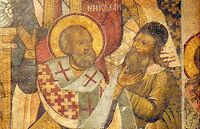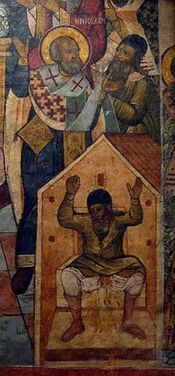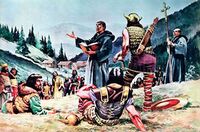Arianism

Arianism, or Arian Christianity was a heresy popular in the Roman Empire until it was sat upon in the 5th century by an alliance supporting the rival Nicene variety. Briefly, Arians believed that Jesus was 'God-like' but inferior to the main boss. Arianism remained popular with some barbarians including the Goths and Vandals for a bit longer but eventually died out in the 7th century. The Catholic and Orthodox churches then destroyed all evidence of this rival Christianity so thoroughly that today no one is quite sure what Arians actually believed in, except it was 'all bad.'[1]
Origins[edit]
Arian Christians are named after a Libyan born priest called Arius (250-336). Though, like all Christians, he had to stay off the radar at a time of persecution, discrimination, and blackballing, Arius developed a theology that suggested God was superior to Jesus on issues like whose turn it was to take the dog for a walk or clean the car. God had made Jesus with the Holy Spirit to produce him, via a surrogate mother called Mary. Arius's overall boss Patriarch Alexander of Alexandria was slow to understand this doctrinal difference and let Arius carry on propagating his message. However, Arius had a modern sense of publicity and used sea songs to explain how his theology worked:
- Semolina Pagan
- Climbing up the Column of Trajan
- Elementary penguin singing Ave Maria
- Man, you should have seen me kicking Athanasius down
Spread[edit]
Arius's revised theology moved from Egypt to across the Middle East quickly. His attempt to resolve the exact relationship between God and Jesus was popular. Jesus in this version of Christianity was almost the equal of God but not quite. He could become God, if God were to take early retirement and go back to his garden to grow turnips.
This dispute bubbled in secret until Roman Emperors Constantine the Great and Licinius published their "Edict of Toleration" in 313, letting the Christians come out in the open, leaving their catacombs and caves for a dose of envigorating fresh air and warm sunlight.
Perhaps being able to go about as codex-carrying Christians encouraged them all to start theological (and physical) fights over the true nature of Christianity. There hadn't even been agreement about what a mess of mouldy documents, parking fines, shopping lists and various discarded pairs of sandals were meant to be part of this particular religion. Nor had the relationship between God, Jesus, the Virgin Mary, and St. Uncle Tom Cobley been sorted out. Arius's teachings were making the religious running and had a good chance of becoming the only acceptable version. This situation dragged on until Emperor Constantine re-united the Roman Empire by deposing and then murdering Licinius in 323. With the slogan, One Man, One Empire and One Christianity, Constantine called a conference or council to meet him in Nicaea.
Arius loses his cassock[edit]
The Arians arrived in force and believed they would be able to bend the Imperial ear in their direction. However, the other Christians gathered rejected Arius's arguments as regards Jesus and claimed he was equal with God. Arius naturally thought this sounded like Christians supported Two Gods. In fact, the particular veneration of the Virgin Mary shown by many anti-Arians suggested this was now a Three-God pantheon, unlikely circumstances for a religion that claimed to be the 'New Testament' to carry on God's supposed work in the Old Testament.
Though Arius appealed to Constantine, the others rejected his views on Jesus. However, then came the tie-breaker, which would apply to all future Church Councils. The losing side of the debate had to admit they 'lost' and could only stay in communion if they confessed their sins and supported the the council's decisions. Arius refused, for which he got a slap and a punch in the face by Santa Claus (also known as St. Nicholas of Bari). Arius was stripped of all his churchy clothes and forbidden to teach religion unless he humbly grovelled.
The meeting ended with the other Arians either accepting the new 'Nicene Creed' as written up by St. Athanasius or looking for jobs in other fields. Arius and his supporters refused. If it had been down to the Christians there, Arius would have been lynched or burnt, but Emperor Constantine let him live out a retirement in Palestine. That seemed to be the end, but there was another act to follow.
Arianism carries on[edit]
Emperor Constantine believed that as long all Christians were loyal to him, he could let them have their own peculiar beliefs. There was no official state religion as such, so everyone could carry on being a pagan, Jew or something else without hindrance. Abruptly, Constantine so appreciated Arius's learning (and perhaps a line in jokes told against other Christians) that he encouraged the mainstream church to re-admit Arius. When St. Athanasius (now in the powerful position of Patriarch of Alexandria) objected to this lenient treatment of his rival, Emperor Constantine lost his rag and had Athanasius banished instead. Arius's rehabilitation seemed complete and he was invited to Constantinople to make a public show of it in 336. However (according to Nicene Christians), an outraged God intervened and Arius was struck with the runs and completely emptied his bowels, along with his guts, liver and heart behind a pillar. The heretic's soul was then being dragged down to hell for further torments. Charitable folks these Nicenes were.
The death of Arius could have ended his branch of Christianity, but it was carried on by other enthusiasts. Arius's supporters treated Arius as a martyr and blamed a dodgy curry cooked by a Nicene Christian for poisoning Arius. This seems to have been the view of Constantine's son the later emperor Constantius II, who would later champion Arius's beliefs (or at least a modification of them). Another disciple of Arius called Ulfilas chose to spread Arian Christianity to barbaric fashion victims living on the other side of the Roman frontier in Germany and the Balkans. These were the Goths, Vandals, and motley tribes who maintained this form of Christianity for another three centuries, even when it was their turn to invade and occupy territories of the Roman Empire.
It disappears[edit]
Arian Christianity was not especially tolerant, compared to any flavour. Once in power, as they were in Italy, Spain, and North Africa, Arians happily persecuted their rivals if chance came. But then, one by one — either through re-conquest by the Byzantine Empire or a ruler converting in an attempt to strengthen their rule and join what looked to be the 'winning side' — Arianism started to vanish. The last Arian King was the Lombard King Garibald (Gary the Bald), who was deposed by a Catholic uncle in 671 and, most likely, done to horrible death.
Catholics and Orthodox Christians happily destroyed all evidence they could find of Arianism. Books, mosaics, and paintings were ripped up, dug out or burnt. This would later become a Christian habit. The losers in these theological wars had everything associated with them destroyed. It's what Jesus (and God, and Mary) would have wanted. Apparently...
See also[edit]
References[edit]
- ↑ The closest to Arian theology as regards the status of Jesus can be seen in the theology of Jehovah's Witnesses. However, best not say that to their faces.



